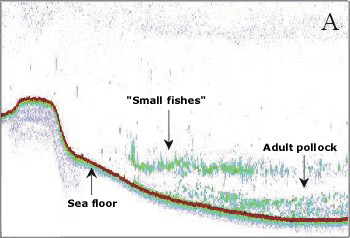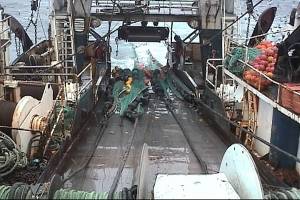| |


 Scientists in the Midwater Assessment and Conservation Engineering (MACE) Program have historically assessed
the status of walleye pollock and Pacific hake stocks from the coasts of California to the Bering Sea since 1977.
The MACE Program continues to assess walleye pollock in the north Pacific and Bering Sea,
while the Northwest Fisheries Science Center has continued Pacific hake assessments
biennially since 2003. Pollock assessment is conducted with midwater trawl surveys combined with acoustic
(echo integration) technology to develop distribution and abundance time series. Research is also conducted on fishing
gear performance and on fish behavior during the capture process in order to develop methods that reduce bycatch in commercial
fishing operations.
Scientists in the Midwater Assessment and Conservation Engineering (MACE) Program have historically assessed
the status of walleye pollock and Pacific hake stocks from the coasts of California to the Bering Sea since 1977.
The MACE Program continues to assess walleye pollock in the north Pacific and Bering Sea,
while the Northwest Fisheries Science Center has continued Pacific hake assessments
biennially since 2003. Pollock assessment is conducted with midwater trawl surveys combined with acoustic
(echo integration) technology to develop distribution and abundance time series. Research is also conducted on fishing
gear performance and on fish behavior during the capture process in order to develop methods that reduce bycatch in commercial
fishing operations.
 Walleye pollock resources in the north Pacific and Bering Sea support the largest single commercial fishery in the
United States and one of the largest commercial fisheries in the world. Surveys to determine the pollock abundance
and distribution are conducted to support NMFS fishery management responsibilities for the territorial sea and to meet
U.S. international fishery management commitments for the Convention on the Conservation and Management of Pollock
in the Central Bering Sea.
Walleye pollock resources in the north Pacific and Bering Sea support the largest single commercial fishery in the
United States and one of the largest commercial fisheries in the world. Surveys to determine the pollock abundance
and distribution are conducted to support NMFS fishery management responsibilities for the territorial sea and to meet
U.S. international fishery management commitments for the Convention on the Conservation and Management of Pollock
in the Central Bering Sea.
Winter surveys of spawning pollock abundance have been conducted annually in the Bogoslof Island area of the Bering
Sea since 1988 and in the Shelikof Strait area of the Gulf of Alaska since 1981. Assessment of summer pollock
abundance in the Bering Sea has occurred routinely since 1979, while Pacific hake abundance off the West
Coast was surveyed from 1977 to 2001. Pollock surveys continue to be conducted in conjunction with bottom trawl
surveys for other groundfish species, and often carried out in cooperation with foreign scientists and foreign research
vessels. The acoustic/midwater trawl survey estimates of distribution and abundance are documented
in various scientific reports and are incorporated into stock assessment advice to fishery management councils,
international fishery management organizations, and industry.
MACE researchers receive NOAA Bronze Medal Award
Seafloor Videos from Bering Sea Research Project
|
Recent Publications, Poster Presentations, Reports & Activities |
- Results of the echo integration-trawl survey of walleye pollock (Theragra chalcogramma) on the U.S. and Russian Bering Sea shelf in June and July 2008.
HONKALEHTO, T., N. WILLIAMSON, D. JONES, A. McCARTHY, and D. McKELVEY.
2009. Results of the echo integration-trawl survey of walleye pollock (Theragra chalcogramma) on the U.S. and Russian Bering Sea shelf in June and July 2008. U. S. Dep. Commer., NOAA Tech. Memo., NMFS-AFSC-194, 56 p. (.pdf, 2 MB). Online.
- Do Silent Ships See More Fish? Comparisons of Walleye Pollock Backscatter Recorded by a Conventional and a Noise-Reduced Research Vessel in Alaska.
ALEX De ROBERTIS, CHRISTOPHER D. WILSON, and NEAL J. WILLIAMSON
2008. Do Silent Ships See More Fish? Comparisons of Walleye Pollock Backscatter Recorded by a Conventional and a Noise-Reduced Research Vessel in Alaska. AFSC Quarterly Report Feature (October-November-December 2008) 6 p. (.pdf, 1.9MB). Online.
- Characterization and classification of acoustically detected fish spatial distributions.
BURGOS, J. M., and J. K. HORNE.
2008. Characterization and classification of acoustically detected fish spatial distributions. ICES J. Mar. Sci. 65:1235-1247.
- Status review of the ribbon seal (Histriophoca fasciata).
BOVENG, P. L., J. L. BENGTSON, T. W. BUCKLEY, M. F. CAMERON, S. P. DAHLE, B. A. MEGREY, J. E. OVERLAND, and N. J. WILLIAMSON.
2008. Status review of the ribbon seal (Histriophoca fasciata). U.S. Dep. Commer., NOAA Tech. Memo. NMFS-AFSC-191, 115 p. (.pdf, 4.78 MB). Online.
- Estimating Unobserved Mortality of Chionoecetes sp. Due to Encounters with Bottom Trawls
By: CRAIG S. ROSE, ALLAN W. STONER, LOVEDAY L. CONQUEST, CARWYN F. HAMMOND, J. ERIC MUNK, JOHN GAUVIN
Conference: Lowell Wakefield Fisheries Symposium (25th), Biology...Crab Populations under Climate Change..., Anchorage, AK, Mar 2009
(2009 poster, .pdf, 802KB.) Online.
- Biogeography of Forage Fish in the Eastern Bering Sea
By: ANNE B. HOLLOWED, ED FARLEY, CHRIS WILSON, STAN KOTWICKI, NED COKELET
Conference: BEST-BSIERP Principal Investigator Meeting, Girdwood, AK, Oct 2008
(2008 poster, .pdf, 661KB) Online.
See the publications and poster databases for additional listings.
|
To view and print these documents, you must install
Adobe Acrobat Reader
freeware. Adobe also offers
free tools
for the visually disabled
|
|
|
|
 Scientists in the Midwater Assessment and Conservation Engineering (MACE) Program have historically assessed
the status of walleye pollock and Pacific hake stocks from the coasts of California to the Bering Sea since 1977.
The MACE Program continues to assess walleye pollock in the north Pacific and Bering Sea,
while the Northwest Fisheries Science Center has continued Pacific hake assessments
biennially since 2003. Pollock assessment is conducted with midwater trawl surveys combined with acoustic
(echo integration) technology to develop distribution and abundance time series. Research is also conducted on fishing
gear performance and on fish behavior during the capture process in order to develop methods that reduce bycatch in commercial
fishing operations.
Scientists in the Midwater Assessment and Conservation Engineering (MACE) Program have historically assessed
the status of walleye pollock and Pacific hake stocks from the coasts of California to the Bering Sea since 1977.
The MACE Program continues to assess walleye pollock in the north Pacific and Bering Sea,
while the Northwest Fisheries Science Center has continued Pacific hake assessments
biennially since 2003. Pollock assessment is conducted with midwater trawl surveys combined with acoustic
(echo integration) technology to develop distribution and abundance time series. Research is also conducted on fishing
gear performance and on fish behavior during the capture process in order to develop methods that reduce bycatch in commercial
fishing operations.
 Walleye pollock resources in the north Pacific and Bering Sea support the largest single commercial fishery in the
United States and one of the largest commercial fisheries in the world. Surveys to determine the pollock abundance
and distribution are conducted to support NMFS fishery management responsibilities for the territorial sea and to meet
U.S. international fishery management commitments for the Convention on the Conservation and Management of Pollock
in the Central Bering Sea.
Walleye pollock resources in the north Pacific and Bering Sea support the largest single commercial fishery in the
United States and one of the largest commercial fisheries in the world. Surveys to determine the pollock abundance
and distribution are conducted to support NMFS fishery management responsibilities for the territorial sea and to meet
U.S. international fishery management commitments for the Convention on the Conservation and Management of Pollock
in the Central Bering Sea.

